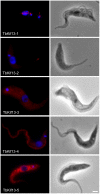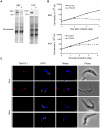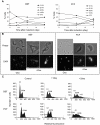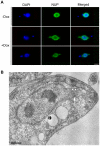Functional characterisation and drug target validation of a mitotic kinesin-13 in Trypanosoma brucei
- PMID: 20808899
- PMCID: PMC2924347
- DOI: 10.1371/journal.ppat.1001050
Functional characterisation and drug target validation of a mitotic kinesin-13 in Trypanosoma brucei
Abstract
Mitotic kinesins are essential for faithful chromosome segregation and cell proliferation. Therefore, in humans, kinesin motor proteins have been identified as anti-cancer drug targets and small molecule inhibitors are now tested in clinical studies. Phylogenetic analyses have assigned five of the approximately fifty kinesin motor proteins coded by Trypanosoma brucei genome to the Kinesin-13 family. Kinesins of this family have unusual biochemical properties because they do not transport cargo along microtubules but are able to depolymerise microtubules at their ends, therefore contributing to the regulation of microtubule length. In other eukaryotic genomes sequenced to date, only between one and three Kinesin-13s are present. We have used immunolocalisation, RNAi-mediated protein depletion, biochemical in vitro assays and a mouse model of infection to study the single mitotic Kinesin-13 in T. brucei. Subcellular localisation of all five T. brucei Kinesin-13s revealed distinct distributions, indicating that the expansion of this kinesin family in kinetoplastids is accompanied by functional diversification. Only a single kinesin (TbKif13-1) has a nuclear localisation. Using active, recombinant TbKif13-1 in in vitro assays we experimentally confirm the depolymerising properties of this kinesin. We analyse the biological function of TbKif13-1 by RNAi-mediated protein depletion and show its central role in regulating spindle assembly during mitosis. Absence of the protein leads to abnormally long and bent mitotic spindles, causing chromosome mis-segregation and cell death. RNAi-depletion in a mouse model of infection completely prevents infection with the parasite. Given its essential role in mitosis, proliferation and survival of the parasite and the availability of a simple in vitro activity assay, TbKif13-1 has been identified as an excellent potential drug target.
Conflict of interest statement
The authors have declared that no competing interests exist.
Figures








Similar articles
-
The expanded Kinesin-13 repertoire of trypanosomes contains only one mitotic Kinesin indicating multiple extra-nuclear roles.PLoS One. 2010 Nov 23;5(11):e15020. doi: 10.1371/journal.pone.0015020. PLoS One. 2010. PMID: 21124853 Free PMC article.
-
The role of the Kinesin-13 family protein TbKif13-2 in flagellar length control of Trypanosoma brucei.Mol Biochem Parasitol. 2010 Dec;174(2):137-40. doi: 10.1016/j.molbiopara.2010.08.001. Epub 2010 Aug 20. Mol Biochem Parasitol. 2010. PMID: 20728476 Free PMC article.
-
Faithful chromosome segregation in Trypanosoma brucei requires a cohort of divergent spindle-associated proteins with distinct functions.Nucleic Acids Res. 2018 Sep 19;46(16):8216-8231. doi: 10.1093/nar/gky557. Nucleic Acids Res. 2018. PMID: 29931198 Free PMC article.
-
Transporters of Trypanosoma brucei-phylogeny, physiology, pharmacology.FEBS J. 2018 Mar;285(6):1012-1023. doi: 10.1111/febs.14302. Epub 2017 Nov 13. FEBS J. 2018. PMID: 29063677 Review.
-
Regulation of the cell division cycle in Trypanosoma brucei.Eukaryot Cell. 2012 Oct;11(10):1180-90. doi: 10.1128/EC.00145-12. Epub 2012 Aug 3. Eukaryot Cell. 2012. PMID: 22865501 Free PMC article. Review.
Cited by
-
The expanded Kinesin-13 repertoire of trypanosomes contains only one mitotic Kinesin indicating multiple extra-nuclear roles.PLoS One. 2010 Nov 23;5(11):e15020. doi: 10.1371/journal.pone.0015020. PLoS One. 2010. PMID: 21124853 Free PMC article.
-
A kinetochore-based ATM/ATR-independent DNA damage checkpoint maintains genomic integrity in trypanosomes.Nucleic Acids Res. 2019 Sep 5;47(15):7973-7988. doi: 10.1093/nar/gkz476. Nucleic Acids Res. 2019. PMID: 31147720 Free PMC article.
-
The Trypanosoma brucei AIR9-like protein is cytoskeleton-associated and is required for nucleus positioning and accurate cleavage furrow placement.Mol Microbiol. 2012 Apr;84(1):77-92. doi: 10.1111/j.1365-2958.2012.08008.x. Epub 2012 Mar 5. Mol Microbiol. 2012. PMID: 22329999 Free PMC article.
-
The microtubule-severing enzyme spastin regulates spindle dynamics to promote chromosome segregation in Trypanosoma brucei.bioRxiv [Preprint]. 2025 Jan 3:2025.01.03.631140. doi: 10.1101/2025.01.03.631140. bioRxiv. 2025. Update in: Commun Biol. 2025 Jul 23;8(1):1095. doi: 10.1038/s42003-025-08505-x. PMID: 39803587 Free PMC article. Updated. Preprint.
-
Mechanochemical tuning of a kinesin motor essential for malaria parasite transmission.Nat Commun. 2022 Nov 16;13(1):6988. doi: 10.1038/s41467-022-34710-x. Nat Commun. 2022. PMID: 36384964 Free PMC article.
References
-
- Dacks JB, Walker G, Field MC. Implications of the new eukaryotic systematics for parasitologists. Parasitol Int. 2008;57:97–104. - PubMed
-
- Gull K. The cytoskeleton of trypanosomatid parasites. Annu Rev Microbiol. 1999;53:629–655. - PubMed
-
- McKean PG, Vaughan S, Gull K. The extended tubulin superfamily. J Cell Sci. 2001;114:2723–2733. - PubMed
-
- Dawe HR, Farr H, Portman N, Shaw MK, Gull K. The Parkin co-regulated gene product, PACRG, is an evolutionarily conserved axonemal protein that functions in outer-doublet microtubule morphogenesis. J Cell Sci 2005 - PubMed
Publication types
MeSH terms
Substances
Grants and funding
LinkOut - more resources
Full Text Sources
Molecular Biology Databases

